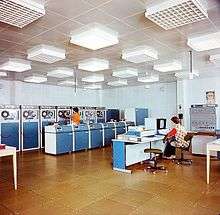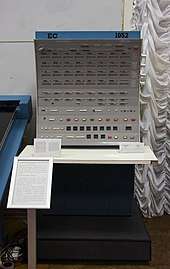ES EVM
ES EVM (ЕС ЭВМ, Единая система электронных вычислительных машин, Yedinaya Sistema Electronnykh Vytchislitel'nykh Mashin, meaning "Unified System of Electronic Computers") was a series of clones of IBM's System/360 and System/370 mainframes, released in the Comecon countries under the initiative of the Soviet Union since the 1960s. Production continued until 1998. The total number of ES EVM mainframes produced was more than 15,000.

In the period from 1986 to 1997, there were also produced a series of PC-compatible desktop computers, called ЕС ПЭВМ (Unified System of Personal Computers); the newer versions of these computers are still produced under a different name on a very limited scale in Minsk.
Development
In 1966, the Soviet economists suggested creating a unified series of mutually compatible computers. Due to the success of the IBM System/360 in the USA, the economic planners decided to use the IBM design, although some prominent Soviet computer scientists had criticized the idea and suggested instead choosing one of the Soviet indigenous designs, such as БЭСМ or Minsk. The first works on the cloning began in 1968; production started in 1972. In addition, after 1968, other Comecon countries joined the project.
With the exception of only a few hardware pieces, the ES machines were recognized in the Western countries as independently designed, based on legitimate Soviet patents.[1] Unlike the hardware, which was quite original, mostly created by reverse-engineering, much of the software was based on slightly modified and localized IBM code. In 1974–1976, IBM had contacted the Soviet authorities and expressed interest in ES EVM development; however, after the Soviet Army entered Afghanistan, in 1979, all contacts between IBM and ES developers were interrupted, due to the U.S. embargo on technological cooperation with the USSR.
Due to the CoCom's restrictions, much of the software localization was done through disassembling the IBM software, with some minimal modification. The most common operating system was ОС ЕС (OS ES), a modified version of OS/360; the later versions of ОС ЕС were very original and different from the IBM OSes, but they also included a lot of original IBM code. There were even anecdotal rumors among the Soviet programmers, that this supposedly Soviet operating system contained some secret command, which outputs the American national anthem. Today some of the Russian institutes that worked on ES EVM are cooperating with IBM to continue legacy support for both genuine IBM mainframes and the ES EVM systems.
The ES EVM were developed in Moscow, at the Scientific-Research Center for Electronic Computer Machinery (НИЦЭВТ), in Yerevan, Armenia, at YerCRDI, and later in Minsk, Belarus, at the Scientific-Research Institute of Electronic Computer Machines (НИИ ЭВМ), in Penza Scientific-Research Institute of Computer Machinery (Пензенский НИИВТ) and manufactured in Minsk, at Minsk Production Group for Computing Machinery (Минское производственное объединение вычислительной техники (МПО ВТ)), in Penza, at Penza Electronic Computer Plant (Пензенский завод ВЭМ). Some models had been also produced in other countries of the Eastern bloc: Bulgaria, Hungary, Poland, Czechoslovakia, Romania and East Germany; some peripheral devices were also produced in Cuba.
The ES computers were produced in subseries, known as Ряд 1, Ряд 2, Ряд 3, Ряд 4 (Ряд [pronounced ryad] means "series").
Hardware models and technical details

The first subseries (ЕС ЭВМ-1) of the ES EVM, released in 1969–1978, included the models 1010, 1020, 1030, 1040 and 1050, which were analogous to System/360 and operated at 10–450 kIPS, and the more rare and advanced versions, incompatible with the IBM versions: 1022, 1032, 1033 and 1052. The electronics of the first models were based on TTL circuits; the later machines used ECL design. ES 1050 had up to 1M RAM and 64-bit floating point registers. The fastest machine of the series, ES 1052, developed in 1978, operated at 700 kIPS.
The second subseries, released in 1977–1978, included the models 1015, 1025, 1035, 1045, 1055 and 1060, analogous to System/370 and operated at 33 kIPS—1.050 MIPS. ES 1060 had up to 8M RAM.
The third subseries, released in 1984, were analogous to System/370 with some original enhancements, and included 1016, 1026, 1036, 1046 and 1066. ES 1066 had up to 16M RAM and operated at 5.5 MIPS. The fourth subseries had no direct IBM analogs and included 1130, 1181 and 1220. The last machine in the series, ES 1220, released in 1995, supported a number of 64-bit CPU commands, 256M RAM and operated at 7 MIPS, but was not successful; only 20 such machines were ever produced, and in 1998 the whole production of ES mainframes was stopped.
- EC 1055
.jpg) EC 5066
EC 5066.jpg) EC 7186
EC 7186.jpg) EC 8607
EC 8607
External links
- (in Russian) Historical Overview of the ES Computers
- (in Russian) Operating Systems of ES EVM
- Pioneers of Soviet Computing